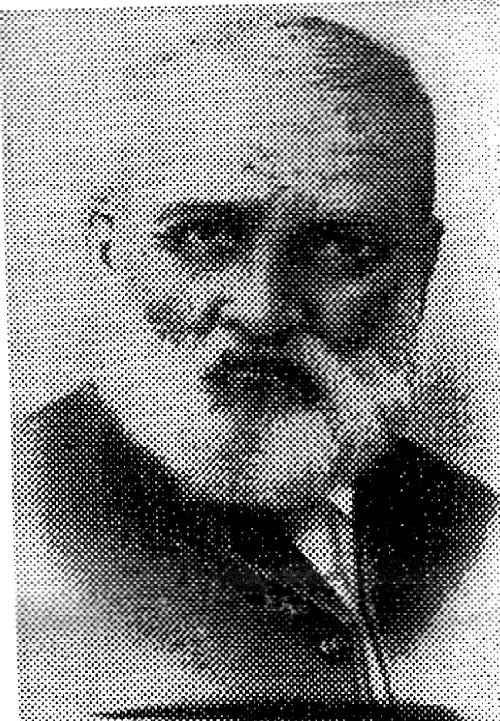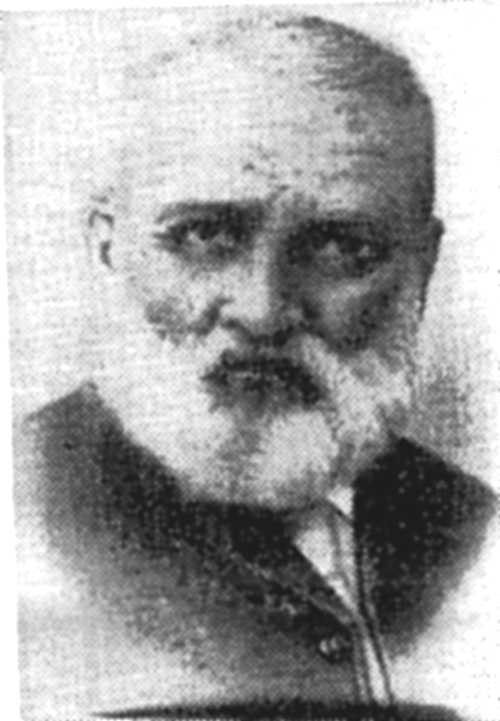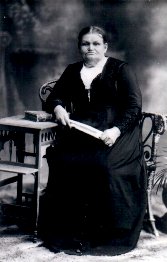CONVICT CHARLIE
By Colleen Fancote


Charlie Fancoat arrived in Western Australia as a guest of Her Majesty aboard the "Ramillies" in 1854. Born in Smethwick, Staffordshire, England on the 26th January, 1828, he was the second son of Richard and Eleanor Fancoat (nee Langstone). As a young man, Charlie was employed as an iron puddler in Smethwick. Iron puddling was an old process for converting molten pig iron from the blast furnace into malleable iron. The pig iron had a high carbon content which made it brittle. It was suitable for casting into fancy shapes and for many domestic iron work uses but it could not be 'worked' with hammers or bent. To reduce the carbon level, the molten iron was puddled in an open hearth furnace to introduce air into it and this burned off the excess carbon. The iron would then be cast into bars ready for rolling into plates or forging into shape with drop hammers.
Smethick's neighbouring city, Birmingham in Warwickshire was growing quite rapidly in the 1840's. The first railway from London to Birmingham had just been completed. A wide variety of manufacturing had grown up - from bedsteads to firearms and jewellery. It was a dirty place with many chimneys, both domestic and industrial, belching smoke. The poor people lived in court houses or back-to backs. The turnover of life was rapid; births, marriages and deaths were recorded at a very high rate at St Martins and St Phillips churches. The size of Birmingham was much smaller than it is today. An old map dated 1840 features the canals at that time. Birmingham is still promoted in some quarters as the 'Venice of the Midlands'. Canals provided the means of transport of raw materials and finished products.
 |
Charlie married Jane Williams on 5th May, 1849, with issue a daughter and son. Jane, a native of Smethwick, was the daughter of John Williams and Sarah (nee Hollington)[Jane had three brothers, Thomas born 1831; William born 1833; and Benjamin, born 1836] . John worked for the parent company to Transy Malleable Iron Works, in or near Birmingham.
Charlie and Jane's daughter, Sara Eleanor was born on 30th January, 1850. Sadly she passed away just 16 days later. Another baby, Thomas was born the next year on 2nd January in Smethwick. Charles worked as a foreman at the iron works in Dunfermline. He had been there in Appin Crescent, Dunfermline for about seven months, on the opposite side of the railway bridge from the iron works and just five minutes from the town centre. The housing, built by the Weardale Company, was to become typical in style for those times - two storied with carved arched doorways. |
The homes were very close together, side by side and back to back in rows. Many of the iron works` English employees lived in them. This was then a new style of architecture for the town and today a row of about eight houses still exists in the same street, from which you can get an impression of Charlie and Jane's lifestyle in 1851/52.
In late 1851 Charlie worked for Transy in Dunfermline, Scotland which commenced operations in 1846. It was backed by local capital (£15,250 purchase price) but unfortunately operated for only six years. [The chimney stacks were blown down by gunpowder charges by the end of December 1856. From the beginning, the works were an unfortunate venture and unhappy speculation] .
Unfortunately Charlie had a disagreement with a fellow worker named Michael Harrigan. Mutual bad feelings festered for over a week. On Saturday 14th February, 1852, Charlie and Harrigan were drinking at a public house (hotel) with their own parties of friends. Charlie came up to the bar for drinks at the same time as Harrigan. Keen to see an end to the upset, Charlie suggested "let's be friends and forget it". They shook hands but Harrigan threw his drink over Charlie, not once but twice! The third time Harrigan hit Charlie in the mouth and nose causing a nose bleed. Mr Taylor, the publican advised the men to stop fighting and warned them that if they continued they would be thrown out.
At the end of the night Taylor sent Harrigan and his friends home first and asked Charlie to wait for about 30 minutes before leaving. Charlie did as he was bid and when all was clear, he and his party turned into High street heading toward Charlie's home in Appin Crescent. His friends waved goodbye and departed, but Harrigan and his party had planned an ambush and jumped out from a laneway. Charlie managed to get free and went straight to a flesher shop (butcher) to borrow a big knife for protection. Mr Henderson, the butcher, asked for what purpose the knife would be used and Charlie answered "to cut some meat up".
As Charlie was heading home, Harrigan came towards him with a brick with intent to kill, but Charlie turned around just in time. The knife went straight into Harrigan's chest and he yelled out "God almighty, I am struck!" and fell to the pavement. Charlie ran off eastward toward a bridge and into a plantation.
Harrigan tried to run after him yelling "catch him, catch him". This bought attention to some of the shop owners and bystanders who were out that night. Dr Kinniburgh, Esquire and James Morrison (surgeon) were called and arrived in minutes, but too late for Harrigan. The wounded man was quite speechless when the doctors arrived (I wonder why!)
The doctor later described that on arrival he found a young chap about 20 years old wearing a white moleskin jacket and a dark coloured vest, smeared with wet blood. He then proceeded to put his forefinger into the wound up to the last joint. The blade had entered the body in a downward direction - the instrument must have been plunged in with great force and come out in the back between the 8th and 9th rib.
The doctor performed a post mortem on the Monday. The body parts were taken on Saturday and preserved in spirits for evidence.
Police were also at the crime scene and a witness told them which direction Charlie had run. He was found hiding under some bushes in the plantation. Charlie had dropped the bloody knife as he ran over a railway crossing. The sheriff, John Habblick apprehended Charlie and made a sketch of the crime scene. Charlie said he had no intention of killing Harrigan and that he only had the knife for self defence.
Charlie was then taken to prison and the trial date was set for 18th February, 1852. He declared at the trial that he did have the knife but only for self defence and that the deceased unfortunately fell onto the knife. The jury found Charlie guilty of murder but recommended him for mercy due to the strong provocation he had received from Harrigan. The judge, Lord Cockburn, then handed down his sentence. The black cap was usually placed onto the judge's head, as was the custom when passing death sentences but Lord Cockburn dispensed with the cap as he was deeply moved by this case. Charlie had never been in trouble with the law and he was a man of good character and a respected member of the community. In his closing remark before passing sentence, the judge found that the murder was brought on by two things: intoxication and revenge. He said "I ascribe the whole of what you did, your conduct was extraordinary for a man of your nature and character." The judge then passed the death sentence, which was obligatory as a man had died. Charlie was then taken away to the prison at Perth, Scotland. He was incarcerated there until being transferred back to Dunfermline prison pending the day of his execution by hanging on 25th May in Dunfermline public place.
Grounds for a petition were taken up by his wife, Jane and Rev Dr MacMichael, Rev Mr Chalmers and many other leading citizens from Dunfermline including the Lord Justice-Clerk at the time and members of his native town Smethwick. A petition of 1250 signatures was collected and sent to Queen Victoria care of the Home Office. The grounds upon which the petition were based were his former good conduct, the great provocation he had received from Harrigan and the fact that he was going directly home by the shortest way possible, as Charlie knew Harrigan was after revenge. Harrigan had taken a long route away from his home, which was on the other side of Dunfermline, with the intention of "doing him in".
On 17th May 1852 a reply came to Rev Dr MacMichael and Rev Mr Chalmers along with Mr Cumming Bruce, MP which was read out to Charlie. Charlie was said to be most affected by the reply and expressed gratitude to all concerned and promised to testify his obligations by the blamelessness of his future conduct.
Charlie's sentence was subsequently commuted to life imprisonment and transportation to the colonies of Western Australia for the term of his natural life. Jane returned home to Smethwick and lodged with friends, Thomas and Eliza Jones in Cross Street. She supported herself by dressmaking.
Reports from records at Dunfermline Prison, Millbank (1605) and Pentoville (4665) show Charlie, in all the prisons, to have been of good character and conduct. He finally left the port of Portsmouth on 2nd May 1854 on board the "Ramillies" and arrived in Western Australia on 7th August 1854 after a journey of 79 days. 280 other convicts were onboard. At Fremantle prison, Charlie was assigned the number 3104. He was awarded his Ticket of Leave in 1858 under J.J. Harwood of Fremantle to work in the whale industry.
Charlie's Conditional Pardon was granted in 1862. He then made his way out to Kelmscott where he worked with Mr Buckingham and became a pit sawyer in the district. Eventually he employed six other Ticket of Leave convicts from Fremantle.
Jane, Charlie's wife, did write in 1858 asking about Charlie's welfare and the Colonial Secretary replied to say that he was well and working in the whale industry. By 1871 Jane and Thomas were living in Cross Street, Smethwick with Jane's mother, who was a widow. Young Thomas had become a carpenter and in 1877 he married Sarah Mann.
In Australia, convicts who had no hope of reuniting with their families in England, were entitled to remarry after a suitable period. Charlie met Caroline Buckingham and married her in 1871. Despite his age of 43 years, he raised another family of ten (five boys and five girls).
Through their industry, Charlie and Caroline bought all the land from the Canning River to Kelmscott Hotel and my family still owns one section of Charlie's original land holding. He became a very distinguished gentlemen of the district and helped the community of Kelmscott with buildings etc around the area.
Caroline died in Kelmscott on 13th September, 1915. Charlie died on 24th October, 1899. This respected couple are both buried in graveyard at the St Mary in the Valley Church of England, Kelmscott. Fancote Street, Kelmscott perpetuates the contribution they made to the district.
In 1998, with my sister-in-law, I visited the locations where the events in Charlie's life took place. We found the approximate spot where the murder occurred. Mr Taylor's public house is still a hotel to this day and fully operational. While discussing the spot of the murder, my sister-in-law and I received a very unusual feeling, as if Charlie was there watching us and directing us which way to go. Everything fell into place. We easily located the public house, the sherriff's office and the cells where the prisoners were held. The only place we could not get a bearing on was Mr Henderson's flesher shop.
Incidentally, back in 1852, on the Monday following the murder, two Englishmen who worked at the iron works were attacked after leaving the public house in Pilmuir Street. The culprits were two Irish men, who also worked at the iron works. The Englishmen were kicked and knocked down with bludgeons and abused in a savage manner. The two victims were hospitalised, and one of them was in a critical condition. The attackers were never found. The incident was said to be revenge from the murder of their friend on Saturday, 14th February. A bitter feeling existed between the English and Irish and it was thought that this might lead to further conflicts in the town.
Sources:
From the Reid Library at University of W.A.: "The Scotsman Newspaper" 18 & 21 February 1852 and 21st May 1852;
Circuit Journeys-Northern Part April 1852 Account of a Travelling Judge;
Shipping Information: "County of Hampshire" Vol. 5 Q942.
From WAGS: "How to Trace Your Scottish Ancestors" by the Scottish Record Office;
From the Scottish Record Office, Edinburgh: The precognition or pre trial evidence & court trial (referenced from the WA Convict Directory WAGS/Battye).
Battye Library: Prison records(microfilm).
State Archives: Ticket of leave (microfilm).
Other: Parish Records of Staffordshire;
"The Drill Magazine" - Congregation Church,
Kelmscott; Department of Lands Administration - land titles.
Information from family members.
Dunfermline Journal Newspaper February 1852
Annals of Dunfermline by E R Henderson 1060-1870
Census information 1851; 1861; and 1871.
"Dunfermline Journal" May 1852
Statistical Account
Dunferline Library and the Heritage Centre.
updated 27 December 1998
|